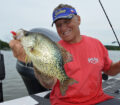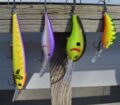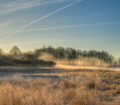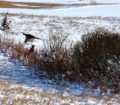By Bob Jensen
Fishing the Midwest Fishing Team

(photo by Bob Jensen) A jig in the spring and early summer is what walleyes like to eat.
If walleyes live near where you live, they can be caught right now. Some states, and some areas of some states have a closed season on ‘eyes, but with just a little travel, you can get to areas that have walleye fishing happening now, and those areas are probably closer to you than you think. Following are some ways to get in on the action.
From now until late spring and early summer, rivers are where the most walleye action is taking place. As the water warms, as the days get longer, and as the current increases, the walleyes feel the urge to start spawning. They’ve probably been feeling that urge for a while now, but the warmer water and other changes move them closer to the actual spawn time.
Most of your catch this time of year will be smaller males, but there is always the chance that a big one will eat your bait. If you want a meal of fresh walleye, keep the smaller ones.
Most walleye chasers this time of year will be using jigs. Jigs are great walleye catchers any time of the year, but they’re especially productive now.
Start with a jig/plastic combo. In many areas the walleyes will be shallow. Wading can be very productive. Spend your time fishing water less than eight feet in depth. Often, water only two or three feet deep will be best.
Depending on depth and current, an eighth ounce jig head can be good, but a sixteenth ounce jig can be very productive at times also. Go with the heavier jig in deeper water or when the current is stronger, the lighter one in shallow water or when there is less current. Add a Mr. Crappie Grub or the smaller Rage Swimmer to your jig. Bright colors are usually better when the water is a little stained. Use a body color that contrasts with the jig color. An orange head and chartreuse body is a popular combination.
If action is slow and you’re convinced that walleyes are in the area, replace the plastic on your jig with a minnow. Or just add a minnow to the jig/plastic. Let the fish show you what they want. A three inch minnow will be about right this time of year.
The fish will usually be over a sand, gravel, or rock bottom. An angler can drag a jig/minnow combo over the sand and gravel, but rocky bottoms will eat too many jigs that are dragged. When fishing over rocks, swim the jig/plastic just above the bottom. A straight, slow retrieve is most productive most of the time, but also try a soft lift/drop retrieve.If Mr. Walleye doesn’t respond to that, try using a slip-bobber to suspend the jig above the rocks. Allowing a jig to drift just above the bottom as it works with the current suspended under a bobber can produce when nothing else does.
Move your jig a little faster until you find an area that has willing walleyes, then slow down a bit and really work the area thoroughly.
Be careful when wading. Avoid areas with a slippery, uneven rock bottom. Stay out of fast current and away from water deeper than your knees. You don’t want a frigid river bath to keep you from being part of this walleye fishing action.



















